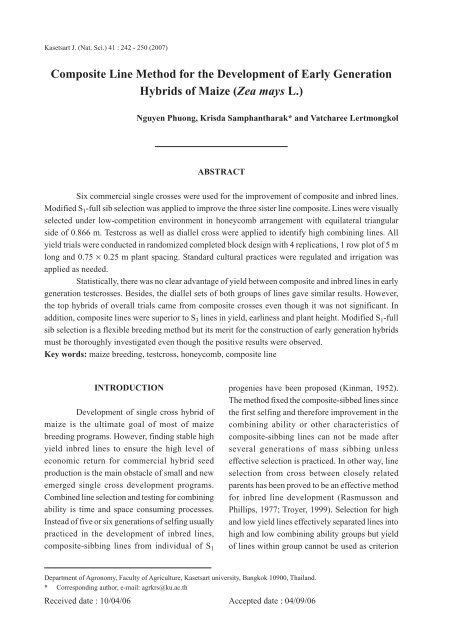April - June 2007 - Kasetsart University
April - June 2007 - Kasetsart University
April - June 2007 - Kasetsart University
Create successful ePaper yourself
Turn your PDF publications into a flip-book with our unique Google optimized e-Paper software.
<strong>Kasetsart</strong> J. (Nat. Sci.) 41 : 242 - 250 (<strong>2007</strong>)<br />
Composite Line Method for the Development of Early Generation<br />
Hybrids of Maize (Zea mays L.)<br />
Nguyen Phuong, Krisda Samphantharak* and Vatcharee Lertmongkol<br />
ABSTRACT<br />
Six commercial single crosses were used for the improvement of composite and inbred lines.<br />
Modified S 1-full sib selection was applied to improve the three sister line composite. Lines were visually<br />
selected under low-competition environment in honeycomb arrangement with equilateral triangular<br />
side of 0.866 m. Testcross as well as diallel cross were applied to identify high combining lines. All<br />
yield trials were conducted in randomized completed block design with 4 replications, 1 row plot of 5 m<br />
long and 0.75 × 0.25 m plant spacing. Standard cultural practices were regulated and irrigation was<br />
applied as needed.<br />
Statistically, there was no clear advantage of yield between composite and inbred lines in early<br />
generation testcrosses. Besides, the diallel sets of both groups of lines gave similar results. However,<br />
the top hybrids of overall trials came from composite crosses even though it was not significant. In<br />
addition, composite lines were superior to S 3 lines in yield, earliness and plant height. Modified S 1-full<br />
sib selection is a flexible breeding method but its merit for the construction of early generation hybrids<br />
must be thoroughly investigated even though the positive results were observed.<br />
Key words: maize breeding, testcross, honeycomb, composite line<br />
INTRODUCTION<br />
Development of single cross hybrid of<br />
maize is the ultimate goal of most of maize<br />
breeding programs. However, finding stable high<br />
yield inbred lines to ensure the high level of<br />
economic return for commercial hybrid seed<br />
production is the main obstacle of small and new<br />
emerged single cross development programs.<br />
Combined line selection and testing for combining<br />
ability is time and space consuming processes.<br />
Instead of five or six generations of selfing usually<br />
practiced in the development of inbred lines,<br />
composite-sibbing lines from individual of S 1<br />
progenies have been proposed (Kinman, 1952).<br />
The method fixed the composite-sibbed lines since<br />
the first selfing and therefore improvement in the<br />
combining ability or other characteristics of<br />
composite-sibbing lines can not be made after<br />
several generations of mass sibbing unless<br />
effective selection is practiced. In other way, line<br />
selection from cross between closely related<br />
parents has been proved to be an effective method<br />
for inbred line development (Rasmusson and<br />
Phillips, 1977; Troyer, 1999). Selection for high<br />
and low yield lines effectively separated lines into<br />
high and low combining ability groups but yield<br />
of lines within group cannot be used as criterion<br />
Department of Agronomy, Faculty of Agriculture, <strong>Kasetsart</strong> university, Bangkok 10900, Thailand.<br />
* Corresponding author, e-mail: agrkrs@ku.ac.th<br />
Received date : 10/04/06 Accepted date : 04/09/06
















